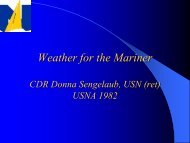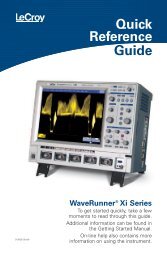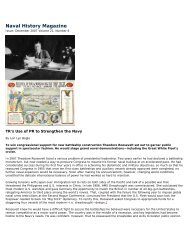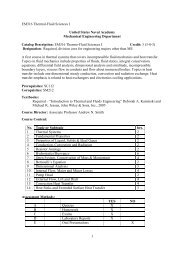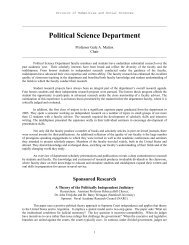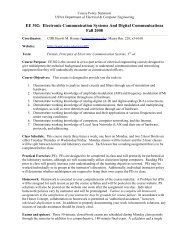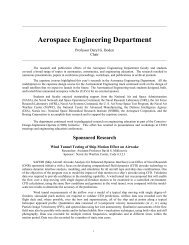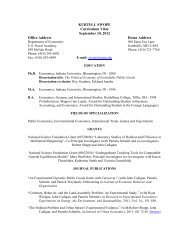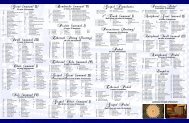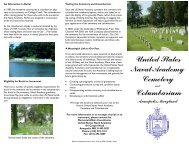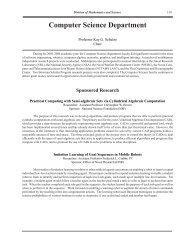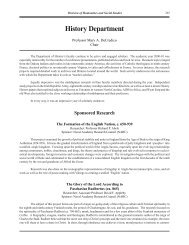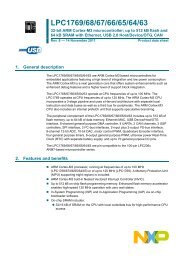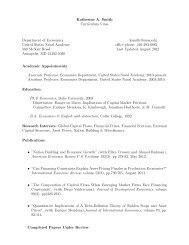William Chauvenet - United States Naval Academy
William Chauvenet - United States Naval Academy
William Chauvenet - United States Naval Academy
Create successful ePaper yourself
Turn your PDF publications into a flip-book with our unique Google optimized e-Paper software.
Bronze plaque at the <strong>Naval</strong><br />
<strong>Academy</strong> and Washington<br />
University in St. Louis<br />
<strong>William</strong> <strong>Chauvenet</strong><br />
<strong>William</strong> <strong>Chauvenet</strong> (1820-1870) (1820 1870) was a mathematician<br />
and scientist who was instrumental in founding the<br />
<strong>United</strong> <strong>States</strong> <strong>Naval</strong> <strong>Academy</strong>.<br />
He established the basis of modern naval education.<br />
<strong>Chauvenet</strong> Hall, home to the Mathematics and some<br />
Science departments, is named in his honor.<br />
<strong>William</strong> <strong>Chauvenet</strong> is enshrined in the pages of American <strong>Naval</strong> History. As a leader, leader,<br />
a<br />
teacher, a scholar, and above all as a man, he will remain forever forever<br />
an inspiration to the<br />
midshipmen, the faculty and the graduates of the <strong>United</strong> <strong>States</strong> <strong>Naval</strong> <strong>Naval</strong><br />
<strong>Academy</strong>.<br />
USNA Alumni magazine Shipmate, 1969<br />
Professor <strong>Chauvenet</strong> was responsible, more than any other one man, for the solid beginning beginning<br />
of the <strong>Naval</strong> <strong>Academy</strong>.<br />
Secretary of the Navy Colonel Frank Knox, 1940<br />
<strong>Chauvenet</strong> Hall
<strong>William</strong> <strong>Chauvenet</strong><br />
Early Years: <strong>William</strong> <strong>Chauvenet</strong> was born near Milford, Pennsylvania in 1820. From an early age<br />
he showed mechanical aptitude as well as striking talent in mathematics, mathematics,<br />
music, and<br />
languages. He entered Yale University at age 16 and graduated four four<br />
years later with high<br />
honors in mathematics and and classics. classics. He then conducted research in meteorology, magnetism,<br />
and astronomy at Girard College in Philadelphia.<br />
In 1841 <strong>Chauvenet</strong> married Catherine Hemple of Philadelphia; they would have five children.<br />
<strong>Naval</strong> Asylum School: Also in 1841, the Navy hired <strong>Chauvenet</strong> as professor of mathematics. He<br />
taught courses at sea briefly, and then moved to the <strong>Naval</strong> Asylum Asylum<br />
School, a shore-based<br />
shore based<br />
facility in Philadelphia, where midshipmen studied basic knowledge knowledge<br />
for eight months. He was<br />
promoted to head the school in 1842, and he immediately instituted instituted<br />
a series of improvements<br />
to the academic program.<br />
<strong>United</strong> <strong>States</strong> <strong>Naval</strong> <strong>Academy</strong>: <strong>William</strong> <strong>Chauvenet</strong> helped convince Navy Secretary George<br />
Bancroft and the U.S. Congress to move the Navy’s Navy s school to Annapolis, Maryland in 1845 and<br />
re-establish re establish it there as the U.S. <strong>Naval</strong> <strong>Academy</strong>. <strong>Chauvenet</strong> was the driving force behind the<br />
academic changes at the new <strong>Academy</strong>. He expanded the course of study study<br />
from eight months<br />
to four years and served as professor of mathematics, astronomy, navigation, and surveying.<br />
His texts on those subjects were widely used across the <strong>United</strong> <strong>States</strong> <strong>States</strong><br />
and remained in print<br />
well into the 20 th century. He also invented the Great Circle Protractor that navigators navigators<br />
use to<br />
find great circle routes, much like Mercator projections aid in finding rhumb line routes.<br />
<strong>Chauvenet</strong> was the first Librarian of the <strong>Naval</strong> <strong>Academy</strong> and built the first first<br />
astronomical<br />
observatory on <strong>Academy</strong> grounds. He was also an early proponent of summer training cruises<br />
for midshipmen and of bringing back outstanding alumni to serve as instructors at the<br />
<strong>Academy</strong>.<br />
He is the ablest mathematician and astronomer which Yale has produced.<br />
produced.<br />
Florian Cajori, Cajori,<br />
1889<br />
I drew up a plan for the expansion of the institution into a regularly regularly<br />
organized<br />
school in which all the subjects conceived to be indispensable to the naval officer<br />
were to be taught under competent instructors. <strong>William</strong> <strong>Chauvenet</strong>
<strong>William</strong> <strong>Chauvenet</strong><br />
Beyond the <strong>Naval</strong> <strong>Academy</strong>: In 1859 <strong>Chauvenet</strong> left the <strong>Naval</strong> <strong>Academy</strong> to become the chair<br />
of the mathematics department at Washington University in St. Louis. Louis.<br />
Three years later he<br />
became chancellor of Washington University. He performed some of the calculations<br />
needed for the design and construction of the famous Eads Bridge across the Mississippi<br />
River in St. Louis.<br />
<strong>Chauvenet</strong> was a major figure in 19 th century American science. He served as vice<br />
president of the National <strong>Academy</strong> of Sciences and president of the the<br />
American Association<br />
for the Advancement of Science. He was a member of both the American American<br />
Philosophical<br />
Society and the American <strong>Academy</strong> of Arts and Sciences.<br />
<strong>Chauvenet</strong> died in 1870 after a long illness.<br />
Navy Honors: Two ships of the U.S. fleet have been named for <strong>Chauvenet</strong>. <strong>Chauvenet</strong>.<br />
The first served as<br />
a minesweeper during World War II. The other was the first of a new class of survey ships<br />
launched in 1968. In that same year the <strong>Naval</strong> <strong>Academy</strong> dedicated <strong>Chauvenet</strong> Hall to<br />
house the Mathematics and some Science departments at the <strong>Naval</strong> <strong>Academy</strong>.<br />
<strong>Chauvenet</strong> Prize: The grace and style of <strong>Chauvenet</strong>’s <strong>Chauvenet</strong> clear writing was much admired by<br />
students and mathematicians. In his honor the Mathematical Association Association<br />
of America<br />
established the annual <strong>Chauvenet</strong> Prize in 1925. The prize is awarded annually to the<br />
author of an outstanding expository paper in mathematics. It is the highest award for<br />
mathematical writing in the <strong>United</strong> <strong>States</strong>.<br />
<strong>Chauvenet</strong> had a power of expression and purity of language unexcelled in American<br />
scientific literature. W. H. Roever, Roever,<br />
1926<br />
References:<br />
Wm H. Roever, Roever,<br />
<strong>William</strong> <strong>Chauvenet</strong>,<br />
<strong>Chauvenet</strong>,<br />
Science (New<br />
Series) Vol 64 No. 1645 (1926) pp 23-28. 23 28.<br />
J. A. Tierney, <strong>William</strong> <strong>Chauvenet</strong>, <strong>Chauvenet</strong>,<br />
Father of the <strong>Naval</strong><br />
<strong>Academy</strong>, Shipmate Vol 32 Sept/Oct 1969, pp 6-11. 6 11.<br />
Wm <strong>Chauvenet</strong>, <strong>Chauvenet</strong>,<br />
letter to Thomas G. Ford, Oct 1860,<br />
History of the Origin of the U. S. <strong>Naval</strong> <strong>Academy</strong>.<br />
Prepared by: Mark Meyerson and T. S. Michael,<br />
USNA Mathematics Department mathweb3@usna.edu<br />
The USS <strong>Chauvenet</strong><br />
Construction of the Eads Bridge in St. Louis



